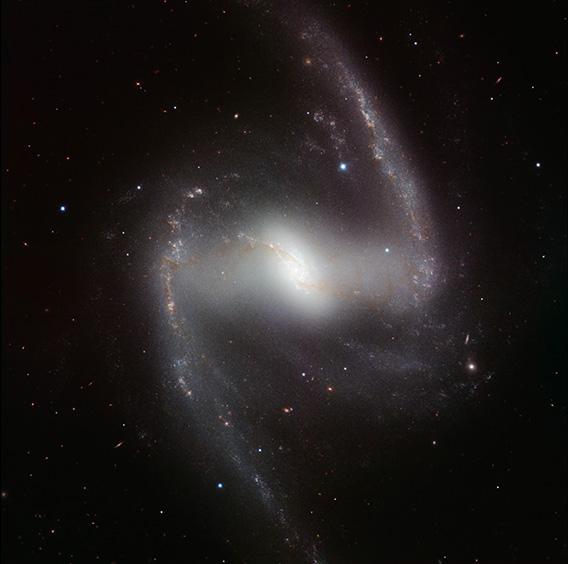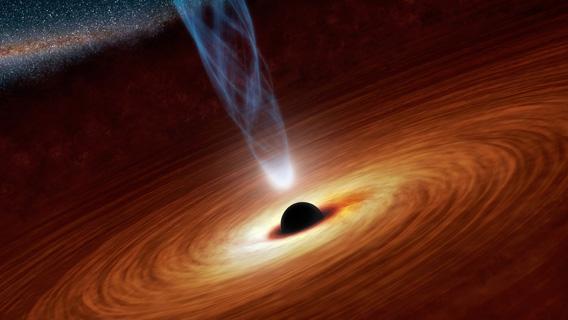Black holes are the Universe’s ultimate garbage disposals: Stuff falls in, and never gets back out. It can’t. To get out, you’d have to travel faster than the speed of light, which (as far as we know) is impossible.
Black holes grow by consuming matter, and in the centers of galaxies they can grow to huge size. In the gorgeous barred spiral galaxy NGC 1365 (shown below), there’s one lurking in the core that has about two million times as much mass as our Sun. Not only that, it is actively gobbling down matter, and that allows us to measure some interesting properties of this cosmic monster, including its spin. Astronomers observed NGC 1365’s black hole using the NuSTAR and XMM-Newton observatories, and were surprised to find out it’s spinning so fast that the outer edge is moving at very nearly the speed of light!
This takes some explaining. Hang on tightly, and for your own safety please keep your arms inside the blog post at all times.
Black holes are confusing, but the bottom line is that they are such highly-concentrated massive objects that their escape velocity is faster than light—I wrote a somewhat more lengthier explanation on the old blog here and here if you want more details. Once something falls in, it cannot get out, but some of the properties of that material remain: specifically mass, spin, and charge. That last bit is literally electrical charge, like how an electron has a negative charge. Physically it’s very interesting, but in practical terms it hardly comes up, so we can ignore it here.
Mass is the critical one, because the more mass a black hole has, the bigger it gets and the stronger its gravity is as well. But spin is important too. Look at, for example, a black hole forming via the collapse of a star’s core when the outer layers explode in a supernova. The core is spinning since the star rotates. As the core collapses, that spin rate increases, in much the same way a skater can increase his or her spin by bringing their arms in close to their body. This is called conservation of angular momentum; objects spinning tend to stay spinning due to momentum, just like any object in motion tends to stay in motion due to momentum. The total angular momentum depends on the object’s size and rate of spin. Increase one and the other must decrease; if you make something smaller it’ll spin faster.
So by the time the core of our doomed star collapses all the way down to a back hole, the spin can be ferociously large.
But there’s more. If there is material around the black hole falling in it can change the spin as well. If material fell straight into the black hole, the spin wouldn’t change much (if anything it would decrease, because the added mass makes the black hole bigger, so, like the skater throwing out his/her arms, the spin slows). But if that material comes in at a slight angle, it can actually add to the spin of the black hole, increasing its angular momentum. That gives a kick to the spin rate, bumping it up.

Image credit: ESO/P. Grosbøl
And that brings us back to NGC 1365, located about 60 million light years from Earth. Astronomers used NuSTAR to look at X-rays pouring out of material falling into the black hole there. As that material falls in it heats up to millions of degrees, blasting out X-rays that are easily bright enough to see from Earth with the right equipment. Careful observations allowed astronomers to see these X-rays coming from matter just before it reached The Point Of No Return, at a position called the Innermost Stable Circular Orbit, or ISCO. If it gets any closer, blooop! It falls in, and it’s gone.
As the material swirls around the black hole, it emits X-rays at a very specific energy—think of it as a color. But as it orbits that color gets smeared out due to the Doppler effect. The amount of smearing indicates how fast the material is moving, and that in turn can tell astronomers how fast the black hole is spinning. This can be complicated by the presence of dense clouds of material farther out from the black hole that absorb X-rays and mess up our observations. The new data from NuSTAR allowed astronomers to show that the smearing seen is definitely due to rotation and not obscuration, unambiguously revealing the black hole’s tremendous spin: just a hair below the speed of light!
Most black holes spin far slower than that, so something ramped this hole’s spin way up. One possibility, as I mentioned above, is material falling in over time. Another is that it ate one or more other black holes, which is creepy but possible. Galaxies collide, and when they do their central black holes can merge, growing larger. If the geometry is just right, this can create a single black hole with more spin. Do this a few times, and you can spin one up to fantastic speeds.
I’ll note that NGC 1365 is a massive galaxy, easily twice as large as the Milky Way (and we’re one of the biggest galaxies in the Universe). That’s exactly what you’d expect from a galaxy that’s spent a lifetime eating other ones. Cosmic cannibals grow fat when the hunting’s good.
This is a pretty amazing finding by the NuSTAR astronomers. It shows that extremely detailed X-rays observations are possible but are very difficult and painstaking to do. It also demonstrates that we can take a pretty close look at black holes and tease out details that were previously not possible to see. This in turn means we can test a lot of the hypotheses we have about these monsters and improve our understanding of them.
By themselves, black holes are invisible, dark, and nearly impossible to observe. But they’re sloppy eaters, and this betrays many of their secrets. Even from 600 million trillion kilometers away.
